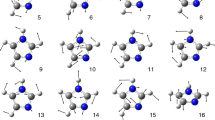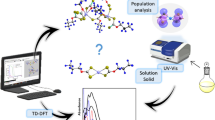Abstract
Modern quantum-chemical and photophysical methods have been used to study the structure of the frontier molecular orbitals and the nature of ligand-to-metal charge transfer (LMCT) transitions of structurally complex d 0-metallocenes. It has been shown that such metal complexes with carboranyl ligands have emissive LMCT states with preferential charge transfer from aromatic π-ligands to the metal and a large electric dipole moment. The electronic excitation and absorption spectra were simulated for the first time, and dipole moments of metal complexes containing metal–carbon σ- and π-bonds were estimated, which is of fundamental importance for the development of molecular photonics.
Similar content being viewed by others
References
Metallocene Complexes as Catalysts for Olefin Polymerization, Alt, H.G., Ed., Coord. Chem. Rev., 2006, vol. 250, no. 1/2.
Loukova, G.V., in Photophysics of Group IV Metallocenes, Chin, H.F., Ed., New York: Nova Sci. Pub., 2010, pp. 159–196.
Armstrong, A.F. and Valliant, J.F., Dalton Trans., 2007, pp. 4240–4251.
Kunkely, H. and Vogler, A., Inorg. Chim. Acta, 2004, vol. 357, pp. 4607–4609.
Frisch, M.J., Trucks, G.W., Schlege, H.B., et al., GAUSSIAN 09, Rev. D.01, Gaussian, Inc., Wallingford, CT, 2013.
Furche, F. and Ahlrichs, R., J. Chem. Phys., 2002, vol. 117, pp. 7433–7447.
Scalmani, G., Frisch, M.J., Mennucci, B., et al., J. Chem. Phys., 2006, vol. 124, p. 094107.
Loukova, G.V. and Smirnov, V.A., Chem. Phys. Lett., 2000, vol. 329, pp. 437–442.
Loukova, G.V., Vasiliev, V.P., Milov, A.A., et al., J. Photochem. Photobiol., A, 2016, vol. 327, pp. 6–14.
Loukova, G.V., Milov, A.A., Vasiliev, V.P., and Minkin, V.I., Phys. Chem. Chem. Phys., 2016, vol. 18, pp. 17822–17826.
Shin, Ch.H., Han, Y., Lee, M.H., and Do, Y., J. Organomet. Chem., 2009, vol. 694, pp. 1623–1631.
Loukova, G.V., Starodubova, S.E., and Smirnov, V.A., J. Phys. Chem. A, 2007, vol. 111, pp. 10928–10937.
Author information
Authors and Affiliations
Corresponding author
Additional information
Original Russian Text © G.V. Loukova, A.A. Milov, V.P. Vasiliev, 2017, published in Doklady Akademii Nauk, 2017, Vol. 476, No. 2, pp. 170–173.
Rights and permissions
About this article
Cite this article
Loukova, G.V., Milov, A.A. & Vasiliev, V.P. Unusual effect of carborane ligands on the electronic properties of d 0-metal complexes. Dokl Phys Chem 476, 157–160 (2017). https://doi.org/10.1134/S0012501617090032
Received:
Published:
Issue Date:
DOI: https://doi.org/10.1134/S0012501617090032




